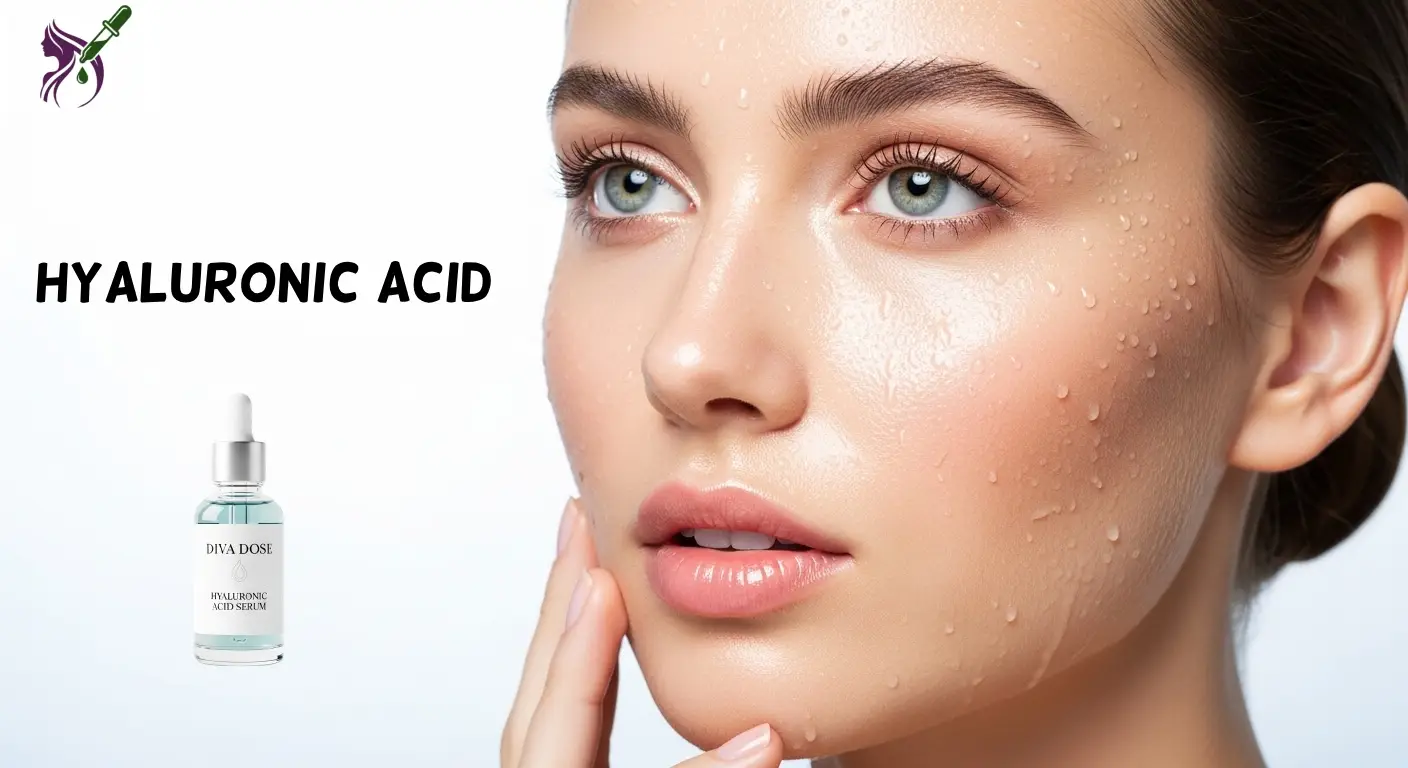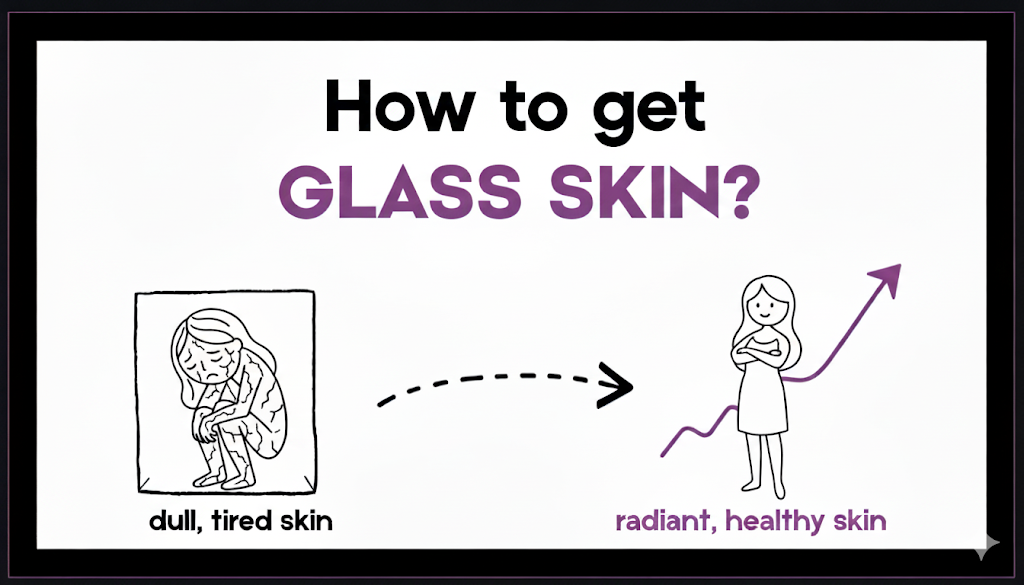To hydrate your skin, increase its water content using humectants like hyaluronic acid, glycerin, or urea, then seal that moisture with occlusives and emollients such as ceramides or squalane.
Hydration begins by cleansing gently, applying a water-based serum to damp skin, and locking it in with a moisturizer. Supporting your routine with adequate water intake, a balanced diet, and a humid environment helps maintain long-term hydration and barrier function.
What is Skin Hydration & Why It is Important?
Skin hydration refers to the water content in the epidermis, specifically in the stratum corneum. Proper hydration provides three main benefits:
- Maintains elasticity.
- Reduces transepidermal water loss (TEWL).
- Prevents fine lines and irritation.
Maintaining hydration improves barrier function and reduces irritation, according to research.
How does dehydrated skin differ from dry skin?
Dehydrated skin lacks water but may exhibit normal or high sebum levels, whereas dry skin lacks oil.
This table compares dehydrated and dry skin to assist in skin type identification:
| Skin Condition | Key Feature | Sebum Levels | Appearance | Common Triggers |
| Dehydrated Skin | Lacks water | Normal or high | Temporary shine, tight, dull | Low humidity, hot showers, environmental stress |
| Dry Skin | Lacks oil | Low | Rough, flaky, tight | Genetics, aging, harsh cleansers |
What is the Difference Between Hydration and Moisturization?
Hydration attracts water into the skin using humectants. Humectants include hyaluronic acid (HA) and glycerin.
Moisturization seals water using occlusives or emollients. Occlusives, such as squalane or petrolatum, prevent water evaporation. Emollients, like ceramides or fatty acids, fill gaps in the barrier and improve texture.
Which ingredients are most effective for skin hydration?
The most effective ingredients for skin hydration are hyaluronic acid, glycerin, ceramides, urea, and occlusives like squalane or petrolatum. These ingredients attract, retain, and seal moisture within the skin, improving elasticity, barrier strength, and overall smoothness.
Humectants
The main humectants for skin hydration are hyaluronic acid and glycerin, which attract and bind water to maintain moisture and elasticity. Secondary humectants such as urea, panthenol, and sodium PCA support hydration by enhancing water retention and soothing the skin barrier.
The following table summarizes the primary functions of humectants:
| Humectant | Primary Function | Benefit | Best For |
|---|---|---|---|
| Hyaluronic Acid (HA) | Binds water molecules to skin | Increases plumpness and elasticity | All skin types |
| Glycerin | Draws water from air and lower layers | Strengthens skin barrier and provides long-lasting hydration | Dry or sensitive skin |
| Urea | Attracts and retains moisture | Softens rough patches and smooths texture | Rough or dehydrated skin |
| Sodium PCA | Maintains water balance naturally | Skin-identical molecule that boosts humectant synergy | Normal to combination skin |
| Panthenol (Pro-Vitamin B5) | Enhances moisture retention | Soothes irritation and supports barrier repair | Sensitive or stressed skin |
| Lactic Acid (low concentration) | Improves hydration through mild exfoliation | Promotes smoother texture and better absorption | Dull or uneven skin |
Hyaluronic Acid
Hyaluronic acid functions as a humectant that binds up to 1,000 times its weight in water. Studies show that it increases skin elasticity and reduces TEWL. HA works best when applied to damp skin.
Glycerin
Glycerin attracts environmental water into the epidermis and strengthens the barrier. Clinical research indicates that glycerin improves moisture retention for up to 24 hours.
Urea
Urea functions as a humectant and mild keratolytic. It improves hydration while smoothing rough patches. Concentrations between 5% and 10% hydrate without irritation.
Emollients
Emollients are lipid-rich ingredients that restore the barrier’s structural integrity. These components improve skin texture and prevent further moisture loss. Emollients fill the microscopic cracks and crevices between skin cells, which supports a smooth, soft texture.
Here’s a quick breakdown of emollients and their role in skincare and hydration:
| Emollient | Primary Function | Benefit | Best For |
|---|---|---|---|
| Ceramides | Refill and reinforce lipid layers | Strengthen skin barrier and prevent irritation | Dry or sensitive skin |
| Fatty Acids (e.g., linoleic, stearic) | Replenish natural skin oils | Enhance softness and support lipid repair | Dry or mature skin |
| Squalane | Mimics natural sebum | Lightweight, non-comedogenic, and locks hydration | Oily or combination skin |
| Cholesterol | Works synergistically with ceramides | Improves resilience and elasticity | Aging or compromised skin |
| Shea Butter | Provides rich, occlusive emollience | Deeply nourishes and smooths flaky areas | Very dry or rough skin |
Ceramides
Ceramides are waxy lipid molecules naturally present in the stratum corneum. Ceramides restore the barrier, reduce water loss, and prevent irritation. Restoration is optimized when ceramides are combined with cholesterol and fatty acids in a specific 3:1:1 molar ratio.
Fatty Acids and Cholestrol
Fatty acids and cholesterol are crucial lipid components that reinforce the “mortar” structure of the skin barrier. Fatty acids supply essential structural material, and cholesterol provides necessary fluidity and structure.
Squalane
Squalane is a highly stable, hydrogenated form of squalene, a lipid found naturally in human sebum. Squalane acts as a potent emollient, preventing Transepidermal Water Loss (TEWL). This component is lightweight, making it an ideal protective lipid for all skin types, including skin prone to blemishes, but not as strongly as classic occlusives like petrolatum or mineral oil.
So, it behaves as a light occlusive, offering mild sealing benefits without heaviness.
Shea Butter
Shea butter is a vegetable fat that is rich in fatty acids. This component exhibits strong emollient properties, which deeply moisturize and soften rough skin. Shea butter is frequently utilized in formulations targeting severely dry skin and irritation.
Occlusives
Occlusives form a protective, hydrophobic layer over the skin’s surface. This physical barrier seals in hydration and prevents the rapid evaporation of water from the outer layers of the epidermis, a process known as Transepidermal Water Loss (TEWL). Occlusives are generally utilized as the final step in a nighttime routine for maximum effect.
This overview details the essential roles of occlusives in barrier function:
| Occlusive | Primary Function | Benefit | Best For |
|---|---|---|---|
| Petrolatum (Vaseline) | Forms a semi-occlusive film to trap moisture | Prevents up to 99% of water loss; ideal for barrier repair | Extremely dry or damaged skin |
| Mineral Oil | Creates a protective barrier on the surface | Non-irritating and effective against dehydration | Sensitive or eczema-prone skin |
| Lanolin | Natural wax that locks in moisture | Provides deep conditioning and softens rough patches | Very dry or chapped skin |
| Beeswax | Natural wax forming a breathable seal | Offers mild antibacterial protection and water resistance | Dry, flaky, or irritated skin |
| Dimethicone | Silicone-based occlusive | Lightweight, non-greasy film suitable for acne-prone skin | Oily or combination skin |
| Squalane | Lightweight lipid with mild occlusive action | Seals hydration without clogging pores; mimics natural sebum | Oily or combination skin |
| Shea Butter | Plant-based butter with dual emollient-occlusive action | Deeply nourishes and locks in moisture overnight | Dry or mature skin |
Petrolatum and Lanolin
Petrolatum (petroleum jelly) is regarded as the most effective occlusive agent, creating a dense barrier that drastically minimizes TEWL.
Lanolin is a wax derived from sheep’s wool that possesses strong occlusive properties, effectively trapping moisture on the skin’s surface. Both components are frequently used to treat severely dry or compromised skin.
Beeswax and Dimethicone
Beeswax is a natural wax that provides a strong, protective occlusive film on the skin. Waxes are known for their high molecular weight, which ensures they remain on the surface to seal moisture inside.
Dimethicone is a type of silicone that acts as a lightweight, non-greasy occlusive. Dimethicone forms a breathable, protective layer that reduces water loss without feeling heavy or oily.
Note: In high-humidity environments, occlusives are typically minimized or avoided. Excessive occlusion in a moist climate can trap sweat and oil, potentially leading to pore congestion or blemish formation.
How to Layer Skincare Products for Maximum Hydration?
A logical layering strategy ensures products penetrate effectively. The optimal sequence for maximum hydration is five steps:
- Seal with a moisturizer or occlusive to lock water inside
- Cleanse gently to remove debris without stripping lipids.
- Apply a hydrating toner or essence to damp skin.
- Layer humectant serums, such as hyaluronic acid or glycerin.
- Strengthen the barrier with ceramides or niacinamide.
How does Hydration Vary According to Skin Type?
Hydration skincare routine must be based on skin type.
| Skin Type | Hydration Focus | Recommended Approach |
|---|---|---|
| Oily Skin | Balance hydration without clogging pores | Use lightweight humectants like hyaluronic acid or glycerin; avoid heavy creams and occlusives |
| Dry Skin | Restore moisture and reinforce barrier | Layer humectants with richer emollients and occlusives such as shea butter or petrolatum |
| Sensitive Skin | Repair and protect the skin barrier | Focus on ceramides, panthenol, and fragrance-free formulations to minimize irritation |
Which Lifestyle Factors Influence Skin Hydration?
Hydration depends on four lifestyle factors: water intake, diet, sleep, and stress management.
| Lifestyle Factor | Primary Function | Hydration Benefit |
|---|---|---|
| Hydrating Diet | Consuming high-water fruits, vegetables, and electrolytes | Improves internal hydration and maintains moisture balance |
| Adequate Sleep | Getting 7–9 hours of nightly rest | Allows skin barrier repair and reduces transepidermal water loss |
| Humidity Control | Using humidifiers or avoiding dry environments | Prevents dehydration caused by low humidity and air conditioning |
| Stress Management | Practicing mindfulness or light exercise | Regulates cortisol, which supports barrier recovery and hydration |
What Mistakes Prevent Effective Skin Hydration?
Three common errors significantly reduce hydration efficacy:
- Over-exfoliation damages the barrier and increases water loss.
- Applying humectants to completely dry skin pulls moisture from the dermis.
- Skipping moisturization or occlusives allows water to escape.
When can you Expect Visible Results from Skin hydration?
While some immediate effects like softer, plumper skin may be visible within minutes to a few days, it generally takes 4 to 6 weeks of consistent use to achieve significant and lasting improvements from a hydrating skincare routine.
Conclusion
Healthy, hydrated skin is the result of consistent care, not a single product. The key lies in balancing humectants that attract moisture, emollients that repair the barrier and occlusives that seal water in. When paired with lifestyle habits like proper hydration, nutrient-rich foods, and restful sleep, this approach creates long-lasting elasticity and a smooth, radiant complexion.
Frequently Asked Questions
How can I tell if my skin is dehydrated or dry?
Dehydrated skin lacks water and feels tight; dry skin lacks oil and feels rough or flaky.
Can oily skin be dehydrated?
Yes. Over-cleansing or harsh products can strip water, causing dehydration even with excess oil.
Is drinking water enough for skin hydration?
No. Internal hydration helps, but topical humectants and moisturizers are required to retain moisture.
When should I apply hydrating products?
Apply humectants and moisturizers on damp skin right after cleansing to trap water effectively.
Can you over-hydrate your skin?
Yes. Using humectants without sealing them can pull water out from deeper layers, worsening dryness.
What’s the best ingredient for dehydrated skin?
Hyaluronic acid or glycerin combined with ceramides gives optimal hydration and barrier repair.




